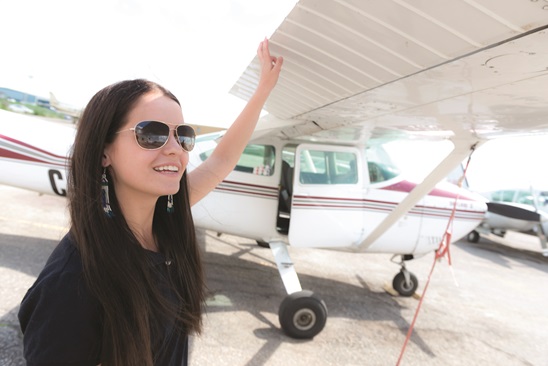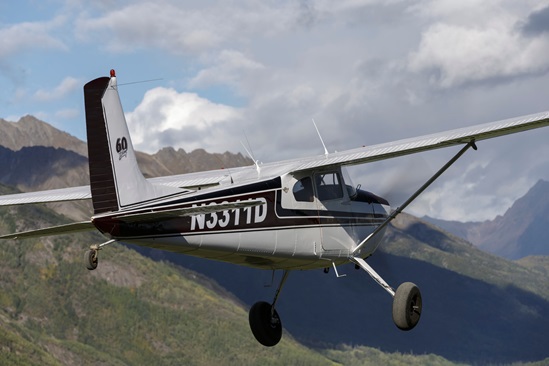| This ePilot Flight Training Edition is sponsored by

Advertisers
                
Do not reply to this e-mail. Got news? Contact ePilot. Having difficulty using this service? Visit the ePilot Frequently Asked Questions now at AOPA Online or write to [email protected].
Aircraft Owners and Pilots Association
421 Aviation Way
Frederick, MD 21701
Tel: 800/USA-AOPA or
301/695-2000
Copyright © 2008 AOPA. | | Training Tips | | 'HEAVY' AIRCRAFT
 A sample question from the private pilot knowledge test question bank asks: "When departing behind a heavy aircraft, the pilot should avoid wake turbulence by maneuvering the aircraft A sample question from the private pilot knowledge test question bank asks: "When departing behind a heavy aircraft, the pilot should avoid wake turbulence by maneuvering the aircraft A) below and downwind from the heavy aircraft. B) above and upwind from the heavy aircraft. C) below and upwind from the heavy aircraft. How did you answer that question? Read the Jan. 24, 2003, "Training Tip" about wake turbulence and then talk to your instructor or e-mail AOPA's aviation experts to see if you answered correctly. Have you had practical experience with this situation? Pilots who fly from airports served by airliners and other large aircraft deal with wake turbulence on a daily basis. When clearing you for takeoff or landing, the tower controller may add to your clearance the phrase "Caution wake turbulence" from the preceding arrival or departure. Although it may seem obvious to the pilot of a single-engine trainer that the preceding aircraft is heavy, the use of the term has special significance, as explained in Chapter 7 of the Aeronautical Information Manual (AIM): "For purposes of Wake Turbulence Separation Minima, ATC classifies aircraft as Heavy, Large, and Small as follows: Heavy—Aircraft capable of takeoff weights of more than 255,000 pounds whether or not they are operating at this weight during a particular phase of flight. Large—Aircraft of more than 41,000 pounds maximum certificated takeoff weight, up to 255,000 pounds. Small—Aircraft of 41,000 pounds or less maximum certificated takeoff weight." Considering those definitions, the AIM describes aircraft separation requirements: "Because of the possible effects of wake turbulence, controllers are required to apply no less than specified minimum separation for aircraft operating behind a heavy jet and, in certain instances, behind large nonheavy aircraft (i.e., B757 aircraft)," as Elizabeth A. Tennyson explains in the AOPA Flight Training May 2001 column "Aviation Speak: Heavy." If you find yourself facing wake turbulence on departure, you may choose to ask the tower to approve an early turn (upwind of the wake's probable drift track) when altitude permits after takeoff. Make this request when you contact the tower for your takeoff clearance. Don't wait until you are airborne, when traffic concerns or frequency congestion can delay approval. Stay alert to hearing the word heavy on the ATC frequency!
| | Flight Training News | | FOREIGN STUDENTS UNDER SCRUTINY, AOPA OFFERS RESOURCES
In the wake of a Feb. 27 ABC News investigative report on background checks for foreign students pursuing flight training in the United States, Sen. Charles E. Schumer (D-N.Y.) earlier this week said an independent investigation of the Transportation Security Administration (TSA) needed to be conducted. With the TSA's background check process for foreign flight students under scrutiny, AOPA reminds flight schools and instructors that they must do their part by following the TSA's guidelines for alien flight training. The place to start is AOPA's Guide to the TSA's Alien Flight Training/Citizenship Validation Rule. Read more on AOPA Online. 2008 CFI OF THE YEAR ANNOUNCED
Max Trescott of Mountain View, Calif., a Master CFI and Master ground instructor, has been named the 2008 CFI of the year by the General Aviation Awards executive committee. Trescott is an independent flight instructor whose primary focus is glass-cockpit aircraft. In 2006, he founded Glass Cockpit Publishing, launched with the release of his book, Max Trescott's G1000 Glass Cockpit Handbook, and followed that up with several CD-ROM and online courses on modern glass-cockpit avionics. The annual GA Awards is a cooperative effort between the FAA and 12 industry sponsors, including AOPA, the Experimental Aircraft Association, the National Business Aviation Association, and Women in Aviation, International. The national awards will be presented in July at AirVenture in Oshkosh. LIBERTY AEROSPACE DELIVERS 100TH AIRPLANE
Liberty Aerospace in Melbourne, Fla., delivered its 100th airplane last week. At a Feb. 27 media event, Connecticut pilot Robert Kinny took delivery of the two-seat XL2, which has a 125-hp Teledyne Continental engine and full authority digital engine control system. Kinny, who learned to fly in an XL2, likened it to a Mazda Miata: "It's an economical, sporty two-seater that handles well and is a blast to fly!" AMELIA REID AVIATION ACQUIRES EVEKTOR SPORTSTAR
Amelia Reid Aviation at Reid-Hillview Airport in San Jose, Calif., has added a 2007 Evektor Sportstar Plus light sport aircraft to its rental fleet. The Evektor joins two Aeronca Champs, a Taylorcraft L2, and a Zlin Savage Cub that are sport-eligible. As the Sportstar is equipped for night flight and basic instrument training, it can also be used for private pilot instruction, according to Amelia Reid Aviation's owner, Zdravko Podolski. GIRLS WITH WINGS AWARDS FIRST SCHOLARSHIP
Girls With Wings, an organization created to promote girls' interest in aviation, has awarded its first scholarship to Brenda Alarcon of Los Angeles, an aviation major at San Jose State University. Alarcon received $500 to be used toward completing a private pilot certificate. She is working two jobs in addition to attending classes full time to be able to afford flight instruction. Requirements for the 2008 scholarship will be announced in August, according to Girls With Wings founder Lynda Meeks.
| | Inside AOPA | | AOPA'S GET YOUR GLASS ARCHER GETS QUIET CABIN
A nice creature comfort of larger airplanes is their relatively quiet cabins. A basic training airplane like a Cessna 152 or 172 isn't built with cabin noise levels in mind. That's why we're trying to make AOPA's 2008 Get Your Glass Sweepstakes Archer into something it has never been—quiet. Learn how the workers at Oxford Aviation in Oxford, Maine, do their best to reduce the noise levels in this week's update. SNAKE ON A PLANE: WHERE'S SAMUEL L. JACKSON WHEN YOU NEED HIM?
During flight training we routinely practice for the unexpected: engine failure, instrument failure, aborted landings. Each scenario has a proper response, and we run through mental or physical checklists as we troubleshoot the problem. But what would you do if, at altitude, a four-foot-long snake suddenly slithered from a hole in your instrument panel? That's just what happened to Monty Coles in his Piper Cherokee. Luckily, he remembered something his first flight instructor had drilled into him. Hear Monty recount the tale—complete with photos of the fork-tongued passenger—in this Real Pilot Story from the AOPA Air Safety Foundation. Then listen to other pilots as they share their true-life encounters with the unexpected. HAVE YOU UPDATED YOUR AOPA MEMBER PROFILE?
To make the most of your membership and allow us to serve you better, please visit AOPA Online and update your personal member profile.
| | Training Products | | 'THE WEATHER BOOK' BY JACK WILLIAMS
AOPA Flight Training readers are familiar with meteorologist Jack Williams' down-to-earth explanations of weather concepts that appear in his monthly column, "The Weather Never Sleeps." Now available from Sporty's is the second edition of Williams' The Weather Book. Subtitled "An easy-to-understand guide to the USA's weather," the book aims to help the reader understand the science behind the weather that pilots fly. New to this edition are sections dealing with global warming, discoveries that are making flying safer, and a discussion of how more hurricanes could hit the United States in coming years. The soft-cover 227-page book sells for $22.95 and may be ordered online or by calling 800/SPORTYS. Note: Products listed have not been evaluated by ePilot editors unless otherwise noted. AOPA assumes no responsibility for products or services listed or for claims or actions by manufacturers or vendors.
| | Final Exam | | Question: My student pilot certificate expires after 24 calendar months, but my third class medical won't expire for 36 calendar months because I'm under age 40. What should I do since my medical and student pilot certificates are on the same piece of paper and one will expire before the other? Answer: The initial student pilot certificate is usually on the reverse side of the medical certificate, so it's typical for student pilots under the age of 40 to face a situation similar to yours. If you haven't earned your private pilot certificate by the termination date of your student pilot certificate privileges, don't worry. Your medical certificate is valid for the next 12 calendar months or until its date of expiration. Simply request a new student pilot certificate from a designated pilot examiner or your local FAA flight standards district office. The FAA will provide you with a stand-alone student pilot certificate so that you may continue your training. Make sure to plan in advance because FAR 61.11 restricts pilots from the privileges of that certificate or rating upon its expiration. Got a question for our technical services staff? E-mail to [email protected] or call the Pilot Information Center, 800/872-2672. Don't forget the online archive of "Final Exam" questions and answers, searchable by keyword or topic.
| | Picture Perfect | Looking for some really fabulous aviation photography? All the air-to-air photos and beautifully detailed ground images used by AOPA Pilot magazine over the years are yours at the click of a mouse button. Download your favorite images to use for wallpaper, send an e-postcard, or order prints online. For more details, see AOPA Online.
| | What's New at AOPA Online | | Who would spend more than two months aloft living in a Cessna 172 eating minced supper from a Thermos? Two young pilots on a mission to set a world endurance record! Fifty years ago Bob Timm and John Cook regularly balanced on their Cessna's wing strut to clean the outside windshield and hoist up the refueling line from the truck speeding below their little airplane. See their adventure come alive in video accompanying the story in the AOPA Pilot special fiftieth anniversary digital edition. The video will automatically load on the front page of the article after a few moments.
| | Weekend Weather |  | | ePilot Calendar | | UPCOMING FLYING DESTINATIONS:
Charlotte, N.C. Jetpool's Future of Business Aviation VLJ Show takes place March 7 and 8 at Wilson Air Center at Charlotte/Douglas International (CLT). See and compare VLJs from many manufacturers and learn at seminars covering "VLJ 101" and specialty topics. For more information, contact Barbara Schick, 704/359-4674, or visit the Web site. Wheeling, Ill. The Chicago Executive Airport Aviation Career Expo takes place March 8 at Chicago Executive's (PWK) Hangar 10. Visit with aviation industry professionals and the nation's top schools to explore the possibility of a career in aviation. For more information, contact Jamie Abbott, 847/537-2580, or visit the Web site. Punta Gorda, Fla. The Florida Aviation Expo takes place March 15 and 16 at Charlotte County (PGD). For more information, contact Carlos Gray, 239/989-1109, or visit the Web site. Sellersburg, Ind. The 2008 Indiana Aviation Safety Seminar for Ultralight, Sport, and Experimental Aircraft takes place March 15 at Ivy Tech Community College. For more information, contact David Graves, 812/216-3106, or visit the Web site. Orono, Maine. The second part of the two-part seminar "Advanced Navigation Equipment and Techniques" takes place March 19 at the University of Maine—Orono. For more information, contact Michael Lessard, 207/422-3015, or visit the Web site. To submit an event to the calendar or to search all events visit AOPA Online. For airport details, including FBO fuel prices, see AOPA's Airport Directory Online. FLIGHT INSTRUCTOR REFRESHER CLINICS
The next AOPA Air Safety Foundation Flight Instructor Refresher Clinics are scheduled in in Orlando, Fla., and Baltimore, March 8 and 9. A clinic is also scheduled in Reston, Va., April 5 and 6. For a complete schedule, see AOPA Online. Can't make it in person? Sign up for the CFI Refresher Online. AOPA AIR SAFETY FOUNDATION SAFETY SEMINARS
AOPA Air Safety Foundation Safety Seminars are scheduled in Birmingham, Ala., and Ypsilanti, Mich., March 10; Marietta, Ga., Springfield, Ill., and Cleveland, March 11; Peoria, Ill., and Whitehall, Ohio, March 12; and Rockford, Ill., and Indianapolis, March 13. The topic is "Top 5 Mistakes Pilots Make." There is also a seminar scheduled in Northbrook, Ill., March 10. The topic is "Do the Right Thing – Decision Making for Pilots." For details and a complete schedule, see AOPA Online.
| |
























